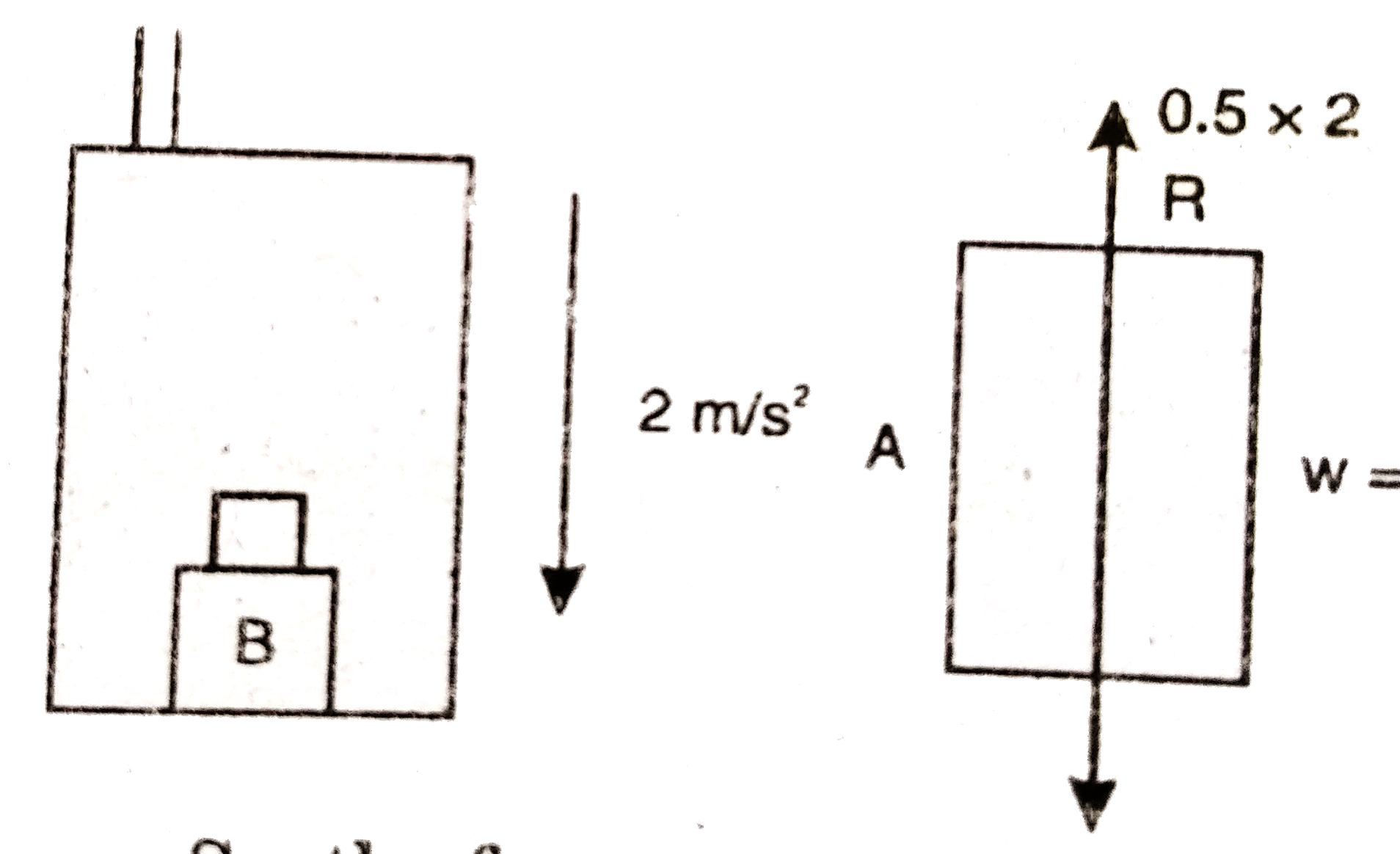A pendulum bobof masss 50 g is suspended from the ceiling of an elevator. Find the tension in the string if the elevator a. goes up with acceleration 1.2ms2, b. goes up with deceleration 1.2ms2, c. goes up with uniform velocity, d. goes down with acceleration 1.2ms2 e. goes down with deceleration 1.2ms2 and f. goes downwith uniform velocity.Solution in Tamil
From the fre body diagram R+0.5+2−W=0
→R=W−0.5×2
=0.5×10−0.5×2
=0.5(10−2)==4N

So, the force exerted by the block A on the block B is 4 N.
Topper's Solved these Questions
- BOOK - HC VERMACHAPTER - NEWTON'S LAWS OF MOTIONEXERCISE - Objective -28videos
NEWTON'S LAWS OF MOTION
- BOOK - HC VERMACHAPTER - LAWS OF THERMODYNAMICSEXERCISE - Short Answer14videos
LAWS OF THERMODYNAMICS
- BOOK - HC VERMACHAPTER - PHYSICS AND MATHEMATICSEXERCISE - Exercises34videos
PHYSICS AND MATHEMATICS
Similar Questions
A refrence frame attached to the earth
02:54View SolutionShould the internal energy of a system necessarily increase if heat is added to it?
02:51View SolutionA vector →A makes an angle of 20∘and→B makes an angle of 110∘ with the X-axis. The magnitude of these vectors are 3 m and 4 m respectively.Find the resultant
05:46View SolutionA small block of mass 1 kg is kept on a rough inclined wedge of inclination 45^@ fixed in an elevator. The elevator goes up with a uniform velocity v=2 m//s and the block done not slide on the wedge. Find the work done by the of friction on the block in 1s . (g=10 m//s^(2))
01:24View SolutionA particle starts from rest, accelerates at 2ms2 for 10 s and then goes for constant speed for 30 s and then decelerates at 4ms2. Till it stops. What is the distance travelled by it?
02:12View SolutionA particle starts from rest, accelerates at 2ms2 for 10 s and then goes for constant speed for 30 s and then decelerates at 4ms2 till it stops. What is the distance travelled by it?
01:11View SolutionA pendulum bob of mass 50 gm is suspended from the ceiling of an elevator. The tension in the string if the elevator goes up with uniform velocity is approximately
01:40View SolutionA man is standing in a lift which goes up and comes down with the same constant acceleration. If the ratio of the apparent weights in the two cases is 2 : 1 , then the acceleration of the lift is : (Take g = 10 m//s^(2) )
02:44View SolutionA particle goes from A to B s with uniform acceleration. Its velocity at A and B are 5 m/s and 25 m/s. Its acceleration (in m//s^(2) ) is
05:33View SolutionA simple pendulum of length 1 m is freely suspended from the ceiling of an elevator. The time period of small oscillations as the elevator moves up with an acceleration of 2m/s2 is (use g=10m/s2)
02:53View SolutionA simple pendulum of length 1 m is freely suspended from the ceiling of an elevator the time period of small oscollations as the elevator moves up with an acceleration of 2m//s ^2 is ( use g=10 m//s ^2)
04:59View Solutionएक कण 200 मी/से के वेग से 60∘ के कोण पर प्रक्षेपित किया जाता है । उच्चतम बिन्दु पर यह तीन समान द्रव्यमानों में विस्फोटित होता है, उनमें से एक 100 मी/से के वेग से ऊपर जाता है तथा दूसरा ऊर्ध्वाधर नीचे की ओर जाता है, तीसरे कण का वेग होगा
03:59View Solution60 kg द्रव्यमान का एक व्यक्ति लिफ्ट में खड़ा है जब लिफ्ट 2m/s2 के त्वरण से ऊपर व नीचे जाती है तो व्यक्ति के भार क्रमश: होगा (g=10m/s2)
04:09View SolutionA simple pendulum of length 1 m is freely suspended from the ceiling of an elevator. The time period of small oscillations as the elevator moves up with an acceleration of 2m//s^2 is (use g=10 m//s^2 )
04:05View SolutionA particle starts from rest, accelerates at 2ms−2 for 10 s and then goes for constant speed for 30 s and then decelerates at 4ms−2 till it stops. The distance travelled is
02:51View SolutionA small block of mass 1 kg is kept on a rough inclined wedge of inclination 45^@ fixed in an elevator. The elevator goes up with a uniform velocity v=2 m//s and the block does not slide on the wedge. Find the work done by the force of friction on the block in 1s . (g=10 m//s^(2))
01:36View Solution

